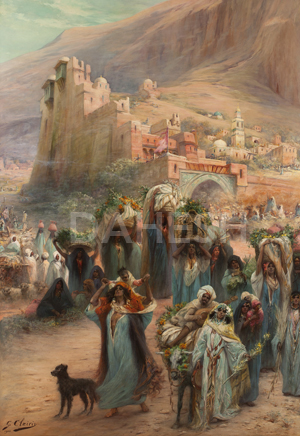Georges Jules Victor Clairin (French, 1843–1919)
In Egypt, the Prosperous Town, Peace (En Egypte, la ville heureuse, la paix), 1913
Oil on canvas, 58 1/2 x 41 in.
Signed and dated lower left: G. Clairin 1913
1996.18

In Egypt, the Prosperous Town, Peace exemplifies Clairin’s later Orientalist style, which became increasingly theatrical, fanciful, and extensively detailed in costume. In this painting, Clairin depicts a sweeping procession of Egyptian figures parading past what seems to be an imaginary town built into the desert cliffs and marked at its entrance by a large, blue-and-white-tiled iwan (a large vaulted space with an opening on one side that is common in Islamic architecture). The peace and prosperity of the town is testified by the bounty of baskets filled with flowers and the earthenware jars that the women carry on their heads as well as the lute played by the man riding the donkey in the foreground — a traditional symbol of harmony and peace. The pendant exhibited alongside this painting at the Salon of 1913, In Egypt, the Town Ravaged by Barbarians (L’Egypte, la ville ravage par les barbes, la guerre) has not been located. Clairin’s pair was well-received. The critic Guillaume Apollinaire referred to Clairin as “a fine Egyptologist” in his exhibition review published in Montjoie! on April 29, 1913 and then praised the pendants for their lyrical quality in his review published in L’Intransigeant on May 14, 1913: “Clairin’s exhibit is, in my opinion, the best thing this painter has done since I have been practicing the art of titillating artists. Did he draw his subjects from The Arabian Nights? It is possible. In any case, there is lyricism in these canvases.”


